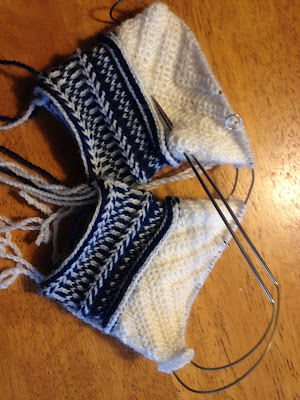I did these 2-at-a-time, in an effort to reduce the differences between the two mittens. It turns out that:
1. 2AAT is easy on single-colour twined knitting! You can use Magic Loop or 2 circs, and you just use 2 centerpull balls and use the yarn management technique described in volume 1 of twined knitting. It's just like socks!
[twined mitts, 2AAT, in progress...]
2. If, like I did, you want to use more than a single colour in parts of the mittens (like, say, in the cuff part), I'd recommend that you estimate how much of each colour you're going to use and wind a centerpull ball starting with one colour. Then, when you've wound up enough of that colour (example: 10 g blue for the cuff), tie on the other colour and continue winding your centerpull ball with the second colour. The result is a centerpull ball with the outside end in one colour and the inside end in the other. Ideal for bi-colour twined knitting!
3. Seems like a lot of twined colourwork is 1x1 - either vertical stripes, checkerboard, braid, or variants thereof. So in each row you use 2 colours alternately, 1 stitch each. If, like me, you want to intersperse these motifs with rows single-colour knitting, you have two options:
[bi-colour centerpull balls, inside portion is blue and outside, white]
- use one of the strands and do a few rows of plain stockinette (not twined knitting), or
- tie on a second strand of the single colour and continue in true twined knitting.
And - perhaps obviously - if you want to execute a design that has floats longer than 1 stitch (zigzags, 2x2 checkerboard), you can still "twine" the two colours on the back over longer intervals. Or, just revert to standard stranded (ie. not twisting the floats) knitting over those portions of the design. Nobody is going to notice the difference, as the emphasis will be on the colourwork, not the structure of the knitting.
Here are some design tips:
I've learned from experience that when you do twined purl, with the yarn twisting in the front of the work, it overhangs the row below it and makes it disappear. So, in the mittens above, I knit two rows of single colour stockinette before doing each braid or ridge motif and one row after it. This makes the braid or ridge look like it is centered on a stockinette background.
One of the fun bits of twined knitting is the "crook" stiches, which are essentially a trio: purl -knit -purl, with the float of the first purl stitch held in front of the knit stitch before being used in the second purl again. In my opinion (having tried both now), monocolour crook stitch patterning (used in the white portion of the mitts above) looks best in a light yarn, rather than in a dark one. White or light grey really makes the texture pop out more - I think because you can see the shadows. You can adapt regular stranded motifs (like scandinavian stars, or zigzag lines) to crook stitches, but the crook stitches require a minimum of 3 stitches to make, so the designs will be wider and "coarser".
You can use single crook stitches (trios) to make "bubbles", or rows of them to make a nice sort of chain (see photo below). Crook stitches done over a striped background are really effective too!
You can use single crook stitches (trios) to make "bubbles", or rows of them to make a nice sort of chain (see photo below). Crook stitches done over a striped background are really effective too!
[Latvian braid on bottom, some purple/white colourwork,
single twined purl rows in purple outlining 2 rows of white crook stitches,
crook stitches on striped background,]
I really love the effects one can get by having both twisted floats on the front of the work. "Latvian Braid" is basically twined purling, with two colours of yarn and the floats in the front of the work. These things are fun to play with, but I've found that you get a horrible jog at the beginning-of-round with them. I've not yet figured out how to solve that problem. In my mittens, I've disguised the jog by the simple expedient of sewing a cord over it - my son wanted the two mittens joined by a long decorative cord so he can keep the mittens hanging in the arms of his coat.
[finished mittens, with idiot cord]




No comments:
Post a Comment